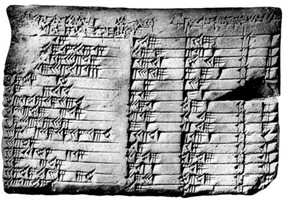SEMESTER PROJECT
The full definition of the Pythagorean Theorem, including the hypothesis, is as follows: Given a right triangle
with legs a and b and hypotenuse c, a2+b2=c2. This theorem is used to find an unknown
length. While that length is usually the hypotenuse, this theorem can also be used to
find either of the legs. The converse of the Pythagorean theorem is also true, and it
is used to test if a triangle is a right triangle. The converse is stated as the
following: ''if a triangle has sides of length a, b, and c, and if a2+b2=c2, then
the angle opposite the side of length c is a right angle.'' Euclid proved the
Pythagorean theorem as well as its converse in his book Elements, which will be shown
later.
The creation of the Pythagorean theorem is first credited to Pythagoras (569-475 BC),
a Greek mathematician who is said to be one of the first mathematicians in history.
He studied with western philosophers Thales and Anaximander, and his work later
influenced other philosophers, such as Plato and Aristotle. Pythagoras believed numbers
were the way to truth and truth itself (Bernholc, 2011; Mark, 2019).
Pythagoras organized a religious/scientific school, or monastery, where the members
held strict rules including wear white clothes, observe sexual purity, do not touch
beans, practice vegetarianism, and much more. The members also held a strict vow of
secrecy. Because of this secrecy, the first proof of the Pythagorean theorem is unknown,
as well as if Pythagoras wrote it. The theorem could have likely been written by his
followers years after he died, but the theorem is still accredited to him (Britannica, 2022).
Scientists have discovered tablets dating to over 1000 years before Pythagoras was born
that show the Babylonians were using Pythagorean triples for surveying land.
Pythagorean triples are positive integers that satisfy the Pythagorean theorem, such as
(3-4-5), (5-12-13), or even (9-40-41). The possible integers that create Pythagorean
triples are endless. While the tablets do not explicitly state the Pythagorean theorem,
they do show that the Babylonians understood the concept of the theorem through the use
of triangles with legs of a length equivalent to 1 in our number system and a hypotenuse
with a length of \(\sqrt 2\) (CK-12 Foundation).


Figure 2 (left): Babylonian tablet Plimpton 322 with Pythagorean triple engravings. (Retrieved from "The Babylonian tablet Plimpton 322")
Figure 3 (right): Babylonian tablet YBC 7289 showing use of Pythagorean theorem. (Retrieved from "The Best Known Old Babilonian Tablet?")
Egyptians may have used the concept of the Pythagorean theorem while constructing their
pyramids. The Egyptians used a rope with twelve evenly spaced knots that could be formed
into a (3-4-5) triangle, with one angle being 90°. It is believed that other various
ancient civilizations had their own understanding and uses of the Pythagorean theorem
as well, many years before Pythagoras was born (CK-12 Foundation).



